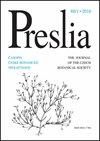芦苇根茎和茎片再生的研究
IF 4.4
2区 生物学
Q1 PLANT SCIENCES
引用次数: 7
摘要
在受干扰和潮湿的生境中,植物从营养碎片中再生是很常见的,但比较不同环境条件下植物不同部位再生的定量数据仍然很少。芦苇(Phragmites australis)是分布在世界各地的优势湿地物种和关键湿地物种。它通过根状茎和匍匐茎进行营养性传播,通过种子进行生发性传播。茎和根茎分离的营养碎片可以支持扰动后的局部再生,并通过水、土壤和其他方式将种群传播到相当远的距离。在南稻中,没有关于茎再生的资料,也没有关于不同来源的无性系之间再生的差异以及环境的影响。在2017年6月中旬至7月下旬的普通盆栽试验中,我们研究了芦苇和根茎碎片在6周内的再生。为了模拟自然界中可能发生的各种情况,我们将茎和根茎(代表繁殖体)扦插在6- 1盆水中,放在沙子表面,并将其埋在5厘米深的沙子中。我们纳入了19个不同的克隆,代表了三个系统地理类群(北美入侵、北美本土和欧洲)的种群。采用广义混合效应模型,考察了系统地理类群、植物部位(茎、根茎)、环境(水、地表、埋藏)、倍性和基因组大小对无性系再生的影响。茎的再生率高于根茎的再生率(分别为69%和37%)。水中的碎块比埋地碎块和沙地碎块的再生效果好(分别为65%、50%和44%)。虽然我们发现芦苇种群在再生方面存在相当大的差异(从北美本土四倍体的31%到北美入侵八倍体的90%不等),但系统地理类群的影响在统计学上并不显著。然而,系统地理类群与植物部分的相互作用,北美入侵种群的茎部再生优于北美本土种群,而根状茎在系统地理类群之间没有差异。这种差异在砂面处理中最为明显。根状茎片段比根状茎片段产生更多的茎和根生物量,北美原生无性系在所有类群中产生的新生物量最少。最后,根状茎的再生速度比茎慢(分别为16天和13天),在水中再生速度最快。我们的研究结果表明,秆片具有很强的再生能力,能够适应各种环境条件,生长迅速,产生新的植株。我们认为这在入侵种群的传播中发挥了重要作用。植物学报93:237 - 254,2021 - 237本文章由计算机程序翻译,如有差异,请以英文原文为准。
Regeneration of Phragmites australis from rhizome and culm fragments
Regeneration from vegetative fragments is common in plants that occur in disturbed and wet habitats but quantitative data comparing regeneration of different plant parts under various environmental conditions are still scarce. Phragmites australis is a dominant and a keystone wetland species that is widespread all around the world. It spreads both vegetatively by rhizomes and stolons and generatively by seed. Detached vegetative fragments of culms and rhizomes can support local regeneration after disturbance and spread populations over considerable distances when transported with water, soil and other means. In P. australis, there is no information on culm regeneration and how regeneration differs between the clones of different origin and what is the effect of the environment. Here we studied the regeneration of P. australis from culm and rhizome fragments over six weeks (mid-June to late July 2017) in a common-garden pot experiment. To simulate various scenarios that can happen in nature, we placed cuttings of culms and rhizomes (representing propagules) in 6-l pots in water, on the sand surface, and buried them 5 cm deep in the sand. We included 19 distinct clones representing populations from three phylogeographic groups (North American invasive, North American native, and European). We tested the effect of phylogeographic group, plant part (culm, rhizome), environment (water, surface, buried), ploidy and genome size on clone regeneration using generalized mixed-effect models. A higher percentage of culms than rhizomes regenerated (69% vs. 37%, respectively). Regeneration was better in fragments placed in water than in those buried and on the sand surface (65%, 50%, and 44%, respectively). Although we found considerable differences in regeneration among particular Phragmites populations (ranging from 31% in one of the North American native tetraploids to 90% in a North American invasive octoploid), the effect of the phylogeographic group was not statistically significant. However, phylogeographic group interacted with plant part – culms of the North American invasive populations regenerated better than those of North American natives, while rhizomes did not differ among phylogeographic groups. This difference was most pronounced in the sand-surface treatment. Rhizome fragments produced greater culmand root biomass than culm fragments and North-American native clones produced the least new biomass of all groups. Lastly, rhizomes regenerated more slowly than culms (16 and 13 days to produce new shoots, respectively), and regeneration was fastest in water. Our results point to a great regeneration ability of culm fragments, which can cope with a wide range of environmental conditions and grow rapidly to produce new plants. We suggest this played an important role in spreading the invasive populations Preslia 93: 237–254, 2021 237
求助全文
通过发布文献求助,成功后即可免费获取论文全文。
去求助
来源期刊

Preslia
生物-植物科学
CiteScore
5.20
自引率
29.40%
发文量
8
审稿时长
>12 weeks
期刊介绍:
Preslia is a peer-reviewed scientific journal publishing original research papers on plant systematics, morphology, phytogeography, ecology and vegetation science, with a geographical focus on central Europe. The journal was founded in 1914 and named in honour of brothers Jan Svatopluk Presl (1791–1849) and Karel Bořivoj Presl (1794–1852), outstanding Bohemian botanists. It is published quarterly by the Czech Botanical Society.
 求助内容:
求助内容: 应助结果提醒方式:
应助结果提醒方式:


